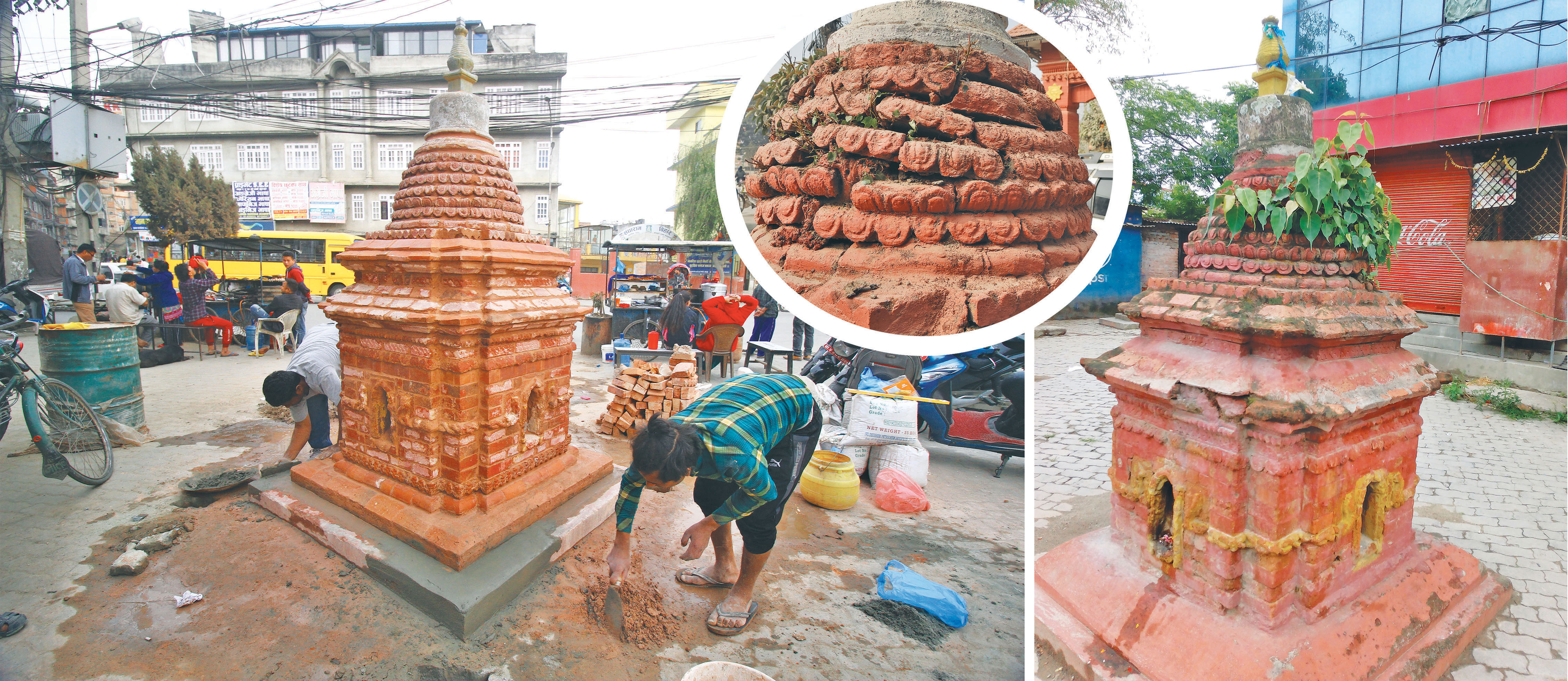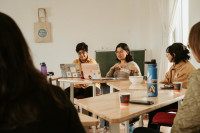Culture & Lifestyle
They started by documenting stupas, now they are restoring them
Restoring a monument takes more than just wishful thinking—it demands hard work and resilience. And Chiva Chaitya, a social organisation, is showing people exactly how it's done.
Srizu Bajracharya
Three years back, Bharat Shahi remembers every day being a whirlwind of confusion. He was trying to restore a worn out chiva chaitya in front of his house at Dallu Chowk and his days would always be busy. For the restoration process, he had to regularly go back and forth from the Department of Archeology’s office to the ward office and to the community’s people, trying to collect more voices for the restoration.
As days went by, he was exhausted and saw almost no hope that the monument he worshipped every day would be put back to its glory. He ultimately gave up entirely. “The stupa was dissipating, chunks of its body were severely cracked, and the layers of asphalt buried its foundation underneath, and for long nobody did anything,” he says.
The shrine, which locals believe dates back centuries, was one of the highlights of the neighbourhood and a major part of the daily rituals of the community. How the monument became forsaken is a long story, he says, one of how time works.
“The family’s elders passed away and their family moved out of the area and they didn’t know the condition of the shrine. While the community people still offer pujas and revere the shrine, nobody had the ownership to repair it and no one really cared enough to initiate its conservation, not even the community's representatives,” he said.
But all that has changed now. The once half-buried and filmed in a layer of dust and grime stupa today stands tall in its renewed grandeur through the initiative of a social organisation Chiva Chaitya. And with the restoration work, footfall has increased multifold. And the milieu of the place has found a facelift, say the locals there. It has become chahakilo, bright in English, says Shahi.
“The people in Chiva Chaitya are doing great work of conserving the uniqueness of the Valley and re-strengthening people’s relationship with the shrines that have surrounded us,” he said. “These shrines are an important part of Kathmandu’s inheritance and culture, one that needs to be preserved,” said Shahi.
Chiva Chaitya’s chiva restoration project started as the country prepared to break from the lockdown of the Covid-19 pandemic. Amid the gloom of an economic collapse across the country, where the tourism industry suffered the most, the group found themselves determined to work on the protection of communal heritage to foster the distinct identity of the Valley’s culture and tourism and people’s relationship with tangible inheritance.

Chaityas, or stupas, are a significant part of Kathmandu’s heritage and culture that goes beyond the Gregorian calendar, says Sumati Bajracharya, a 77-year-old Buddhist intellect and the author of the book ‘Chiva Chaitya’. And the people of the Valley for long have built chaityas wherever they have lived.
The shrines are worshipped on a day to day basis by different ethnic groups on different occasions representing the various phases of life, such as Janko, which is celebrated when an elderly person reaches a certain age, or death anniversaries. Chaityas are a significant part of all the rituals.
Chaityas are also an ode to the dead, made in remembrance of someone endeared. And in Buddhism, chaityas are also regarded as a three-dimensional representation of the mandal that embodies the principle of life. They are also one of the distinctive highlights of baha and bahi monasteries.
“Chaityas have a long history. They existed even before Buddha’s time and the term initially was referred to as a place of resting or meditation, later it was referred to the idea of using, ‘chiti’ (ash) of the deceased to make a stupa in their memory,” said Bajracharya.
“The concept of chaitya has evolved with Buddhism. At first it was just made with earth, without the Pancha Buddhas or the gajur (pinnacle), but today we see all kinds of them, and in many ways their existence attributes to the uniqueness of our culture,” said Bajracharya. And even today, the culture of building chivas has continued in the Newa Buddhist community.
However, over the years, chiva chaityas, which are pieces of heritage and history, have been undermined and overlooked. “In terms of conservation and protecting what we have, people have not understood what these stone monuments mean in our culture—even archaeologically speaking,” said Amar Tuladhar, a board member and the treasurer of Chiva Chaitya.
These shrines have been damaged, shifted, demolished without properly understanding their value, said Bajracharya and Tuladhar, even more with the road construction projects underway. At Dallu, the layers of asphalt used haphazardly to make roads had buried half of its structure.
For the organisation, as they restore chaityas in the valley, confronting the indifference of the people and seeing how the government has not considered the importance of the chaityas has been frustrating. But in each of their restoration projects to date, they have made it a point to work closely with the local ward office, community people and the private owners of the monuments.
“We believe if we are to protect these chaityas, we need to establish ownership—only then, will people question and make more effort in the preservation of the chaityas and their culture,” said Prabin Shakya, the vice-president of the organisation.
Their first restoration project started in Swayambhu, where two chivas (chaitya in Nepalbhasa) had been damaged when a tall tree had fallen over them. The chivas parts were stored in the office of Swayambhu Bikash Kosh for quite some time and nobody knew the whereabouts of the chiva chaityas, said Tuladhar. “The owners of the chaityas had also filed a police complaint, but we were told they were unable to find it and then we went and searched in the Kosh’s store and we found the pieces—they were severely damaged,” he said.
Within a few days, their group dispersed to get permission from authorities, mainly the ward office. Then they managed all resources and brought together the concerned people of the shrine to work on restoring the chaitya.
The restoration cost came to be around Rs85,000, says Tuladhar. But at Dallu, where they had to dismantle the chaitya, replace parts and build the foundation of the shrine, the cost was more.
“The cost depends on how much of the chaitya needs to be restored and how. And with that the size of the chaitya, the workforce needed, and the logistics required,” says Tuladhar. “For these operations, we usually collect money from our friends and benefactors. But oftentimes, the community people have stepped in to contribute to the restoration. It happened in Dallu and even at Dhoka-tole near Hanuman Dhoka Durbar Square,” he said.
In the past five months, the group has restored about five chaityas, and they plan to cover at least six more this year. Just a week back at Dhalko Ward No. 17, next to the Indrayani temple, the organisation restored a terracotta chaitya which they believe to be over hundreds of years old. “A tree was growing from underneath the chaitya, and in the process was tearing down the chaitya’s structure, so we had to dismantle the parts and take out the tree,” said Tuladhar.

With each restoration, Tuladhar and his team have been gathering a lot of praise and support from people. Last year, they were also funded by the World Monument Fund that had also enlisted ‘chiva and chaityas’ of Kathmandu on their watchlist of 2020.
The group that was initiated by five friends—Prabodh Kasa, Prabin Shakya, Suban Tuladhar, Ashish Manandhar and Amar Tuladhar—has come a long way from just discussing the importance of the shrines to actually restoring them. Today, they understand that more than wishful thinking, one needs to take action to make way for the change they want to see.
“We started talking in 2012-13 about how these chaityas are mostly overlooked by the state and the people. We wanted to make people aware of how these shrines are important both culturally and socio-economically. We believe it can attract more tourists too,” said Shakya.
Then, they were a social group that was recording and documenting chaityas in the Valley, trying to create an inventory through images, and their history. Alongside, they also promoted chaityas through community and school interactions, chaitya tours, cultural tourism conservation programmes and cleaning activities. They registered as an organisation in 2019.
And as an organisation, these days they are also working to establish GPS locations of chaityas in the valley. Till date, they have recorded over 1,300 chaityas, but they estimate the count of chaityas in the Valley to be over 4,000, excluding well-known chaityas like Swayawambhu, Khasti, Namobuddha, Dhando chaityas.
Although their work still mostly remains hidden in the larger conversation of heritage conservation, the group’s role has been crucial to start off ground-level mobilisation and motivation and to bring attention to the chaityas that we see in almost every neighbourhood of the Valley.
“This is just the beginning for us, and we believe this journey will continue and expand with people taking their first steps to be aware and then to making steps to protect monuments that already exist around us,” said Shakya, the vice-president.
Anjir Man Baniya, the site manager of the group, has also witnessed this optimism. He has seen the concern of people grow with their attempt to restore the monuments in their community. “A lot of people come asking what we are doing, and if we are doing the restoration in the right way,” he said. At Dallu, he saw about 13 local clubs come together to pull up the chaitya and restore its structure.
Today, the process for him and the team has been heartwarming. “When you first see what you have to fix, it feels like an unimaginable attempt with so much to do, but as the chaitya comes together, nothing beats the peace you find at the end,” he said.
“It’s gratifying to see how you are able to bring everyone together for a cause. The triumph for the team has been in raising concerns of a community in their ownership of the monuments they have lived with.”




 7.12°C Kathmandu
7.12°C Kathmandu















